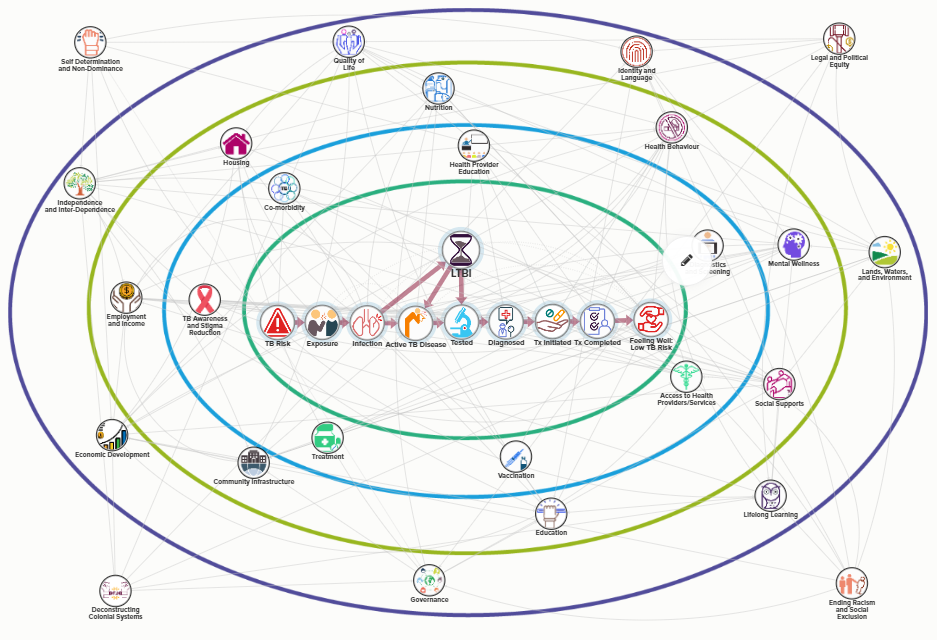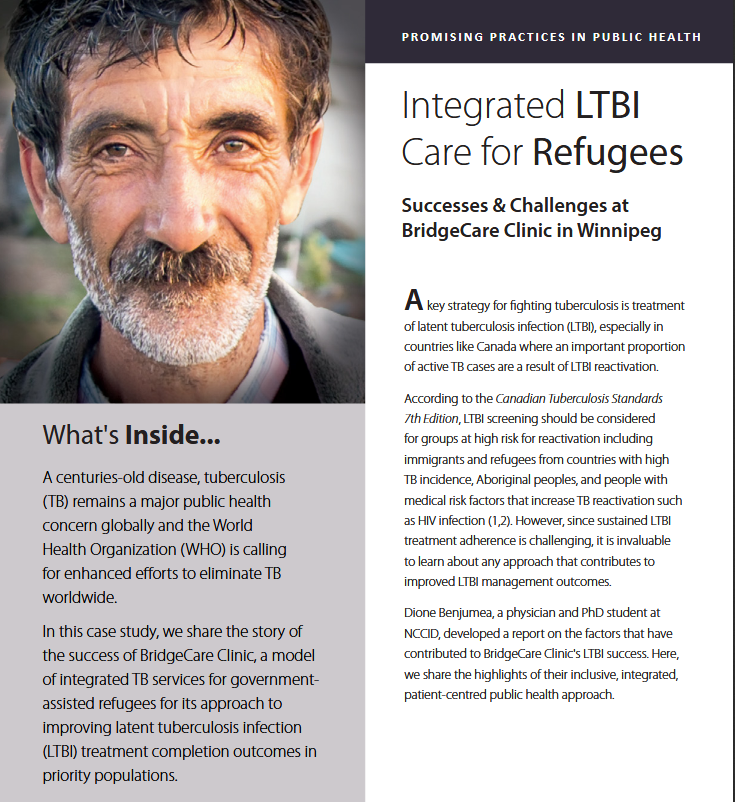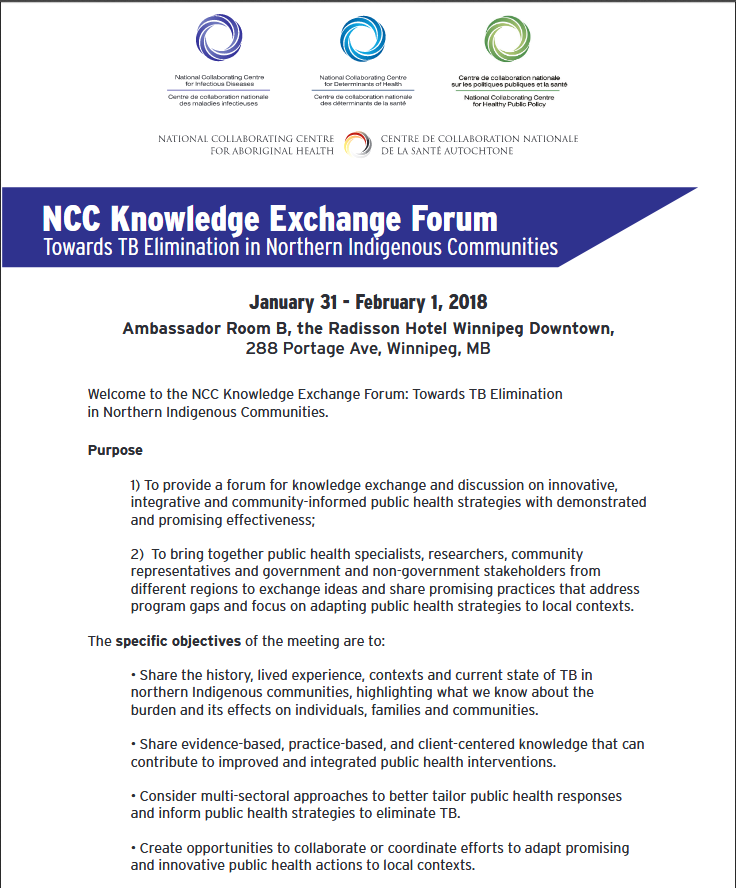
Tuberculosis (TB) is both preventable and curable, yet remains the world’s deadliest infectious disease. Although Canada is a low TB incidence country, TB continues to disproportionately affect First Nations, Inuit, and Métis peoples, and immigrant, refugee, and newcomer populations.
TB in Canada
In 2023, there were 2,217 cases of TB reported in Canada (5.5 new TB cases per 100,000 population). Approximately 79% of these cases occurred among people born outside of Canada (incidence of 15.5 per 100,000). Of TB cases born in Canada, 37% were Inuit (incidence of 204.2 per 100,000), 37% were First Nations (incidence of 18.5 per 100,000), 24% were non-Indigenous (incidence of 0.4 per 100,000), and 3% were Métis (incidence of 2.7 per 100,000). For Inuit living within Inuit Nunangat and First Nations, this corresponds to a rate more than 500 times and 50 times higher than the rate for the Canadian-born, non-Indigenous population, respectively.
TB among First Nations, Inuit, and Métis peoples is a direct result of colonial practices and policies in Canada. Ending TB among First Nations, Inuit, and Métis peoples is vital for Canada to fully implement the Truth and Reconciliation Commission’s (TRC) Calls to Action, particularly #19, the United Nations Declaration on the Rights of Indigenous Peoples (UNDRIP), particularly Article 24, and the Missing and Murdered Indigenous Women and Girls and 2SLGBTQI+ People (MMIWG2S+) Calls for Justice, particularly #3.1.
Canada has pledged to eliminate TB among Inuit in Inuit Nunangat by 2030 and across the country by 2035.
What’s New
Supporting TB Care in First Nations, Inuit and Northern Communities
Join us in the new year for a webinar discussing the social realities of tuberculosis (TB) in First Nations and Inuit communities, and the importance of a culturally responsive approach to TB care. The date and time will be confirmed in the new year.
How Primary Care Providers Can Support Immigrant and Refugee TB Clients
This webinar is part of the Public Health Agency of Canada’s (PHAC’s) Communicable Diseases and Infection Control (CDIC) Webinar Series and is co-hosted by the National Collaborating Centre for Infectious Diseases (NCCID).
Multi-Drug Resistant Tuberculosis: Proceedings from a Virtual Discussion with Public Health Decision- makers and Practitioners in Canada
This report summarizes the proceedings of a dialogue on MDR-TB care in Canada which was held online April 25 and 26, 2023. The event brought together 31 participants, some with lived experience of MDR-TB and some who were policy makers, researchers, and public health personnel from different regions in Canada. The intent of the dialogue was to provide an opportunity for stakeholders to discuss current challenges to the provision of effective, equitable MDR-TB care in Canada and possible solutions.
The State of Tuberculosis Surveillance in Canada: Landscape and Ways Forward
This webinar considers the current state of tuberculosis (TB) surveillance in Canada and what a robust strategic plan supported by high-quality surveillance data could achieve for TB elimination.
Multidrug-Resistant Tuberculosis in Canada: What public health needs to know
In this presentation, we will describe concerns related to global and national multidrug resistant tuberculosis (MDR TB) epidemiology. We will also review key steps in prevention, diagnosis, and treatment. Important challenges faced by Canadian public health systems in responding to MDR TB and solutions to support people who are affected will also be discussed.
Dialogue on multidrug resistant tuberculosis in Canada
To prepare for a potential increase of multidrug-resistant tuberculosis (MDR-TB) in Canada, NCCID hosted an online forum for people affected by MDR-TB, their family members, researchers, policy makers, and practitioners to discuss existing challenges to the prevention and management of MDR-TB and potential solutions.
NCCID Resources
WEBINAR | How Primary Care Providers Can Support Immigrant and Refugee TB Clients (2025)
This webinar is designed to empower primary care providers with essential knowledge on supporting immigrant and refugee tuberculosis (TB) clients.
ONLINE EDUCATIONAL TOOL | TB Journey Determinants Map for Northern First Nations Communities (2025 update)

A dynamic, interactive visual, depicting key stages in a patient’s journey from exposure to treatment completion, and the intersections of medical, social and First Nations determinants of TB that influence their experiences and health and wellness outcomes.
VIDEO | Mathematical Modelling in Public Health: Tuberculosis (2020)

This short, educational video aims to de-mystify mathematical modelling for Tuberculosis prevention and public health planning.
RESOURCE LIST | Public Health Action to address Tuberculosis in Homeless Shelter Settings: a curated list (2020)
A curated resource list to support public health TB programs develop equity-centred public health policy and interventions in emergency housing, and shelter settings.
“TB TALKS” PODCAST (2017-2020)

TB Talks is an NCCID podcast series that shares knowledge to support TB elimination in Canada. If you have any questions or comments about the series, please reach out to the Series Producer, Shivoan Balakumar, at Shivoan.Balakumar@umanitoba.ca.
Season 1 – Conversations at End TB 2017
NCCID speaks to TB experts at End TB 2017, a meeting of the International Union against Tuberculosis – North American Region (NAR). Topics include cultural humility, new digital technologies, Indigenous determinants of TB, and post-landing surveillance.
Season 2 – A Community Outbreak Story
This 4-episode educational docuseries follows the course of a 2019 TB outbreak in a small First Nations community in northern Saskatchewan. Hear the captivating stories of TB survivors and front line workers involved in the response.
Artwork by Ruth Cuthand (Tuberculosis, 2011). [Image: Through vibrant, intricate beadwork, First Nations artist Ruth Cuthand explores the historical connections between colonialism, race, disparity, and disease by depicting microscopic views of pathogens like tuberculosis. Historically, infectious disease and ensuing pandemics disproportionately impacted Indigenous communities as a result of colonialism and genocide. Similar health disparities continue today as a result of entrenched inequity and ongoing structural violence against Black, Indigenous and People of ColoUr. Cuthand’s chosen medium further reflects this complex history: like many infectious diseases, glass beads were first introduced in the Western Hemisphere by European colonizers, who traded the inexpensive items for valuable furs and other goods, and like viruses, they fundamentally disrupted Indigenous ways of life].
REPORT | Shared Priorities for TB Program Performance Measurement in Canada – Proposal for Discussion (2019)
A proposal for collaborative TB program indicator development, based on shared performance measurement priorities identified across high-burden regions and populations in Canada.
REPORT | TB Deliberative Dialogue Summary (2018)
This summary describes key priorities and directions for TB elimination in Canada, as identified during a 2018 deliberative dialogue meeting hosted by the Public Health Agency of Canada, Indigenous Services Canada, NCCID, and the Canadian TB Elimination Network.
RESOURCE LIST | Multi-Drug Resistant Tuberculosis: International Resources for Public Health Personnel (2018)
A curated list of international resources on MDR TB that can be considered and adapted for the Canadian context.
CASE STUDY | Integrated LTBI Care for Refugees: Successes and Challenges at BridgeCare Clinic in Winnipeg (2017)

In this case study, we share the story of the success of BridgeCare Clinic, a model of primary care integrated TB services for government-assisted refugees, for its approach to improving latent tuberculosis infection (LTBI) treatment completion outcomes in priority populations.
WEBINAR | TB Elimination – Public Health Approaches for Priority Populations (2016)
This webinar explores surveillance data in Canada and focuses on topics including programming, infrastructure, emerging technologies and global efforts combating tuberculosis. Request access to the webinar recording, here. Download the companion document for key messages and other helpful resources.
DISCUSSION BRIEF | Public Health Speaks: Tuberculosis and the Social Determinants of Health (2014)
Using tuberculosis as an example, public health practitioners discuss roles, actions and strategies that public health can take to address the social determinants of health and reduce inequities. This resource is a summary of their conversation.
OTHER TB RESOURCES
- Government of Canada’s Tuberculosis Response: Working towards Tuberculosis Elimination (2025)
- National Collaborating Centre for Indigenous Health (NCCIH) – Trauma-informed care in the management and treatment of Tuberculosis in Indigenous populations (2024):
- PHAC – TB in Canada, 2023
- Canadian Tuberculosis Standards, 8th Ed. (2022)
- Canadian TB Standards (8th Ed.) – Chapter 15: Monitoring tuberculosis program performance (2022)
- The BCG World Atlas, 2nd Ed. (2022)
- NCCIH – Indigenous TB Resources Repository (2020)
- Recommendations for TB Management among populations experiencing homelessness – Fraser Health (2020)
- Inuit Tapiriit Kanatami – Inuit Tuberculosis Elimination Framework (2018)
- The Time is Now – Chief Public Health Officer’s spotlight on eliminating tuberculosis in Canada (2018)
- NCCIH – Addressing the Challenge of Latent Tuberculosis Infection Among Indigenous Peoples in Canada (2017)
- Health Canada – Monitoring and Performance Framework for Tuberculosis Programs for First Nations On-Reserve (2016)
- The Online TST/IGRA Interpreter
past EVENTS
NCC Knowledge Exchange Forum: Towards TB Elimination in Northern Indigenous Communities (2018)

PARTNERS
- Stop TB Canada
- Canadian TB Elimination Network (CTBEN)
- First Nations Health and Social Secretariat of Manitoba (FNSSM)
- Indigenous Services Canada (ISC) – First Nations and Inuit Health Branch (FNIHB)
- Northern Inter-Tribal Health Authority (NITHA)
- National Collaborating Centre for Indigenous Health (NCCIH)
- National Collaborating Centre for Determinants of Health (NCCDH)
- National Collaborating Centre for Healthy Public Policy (NCCHPP)
- Public Health Agency of Canada (PHAC)




